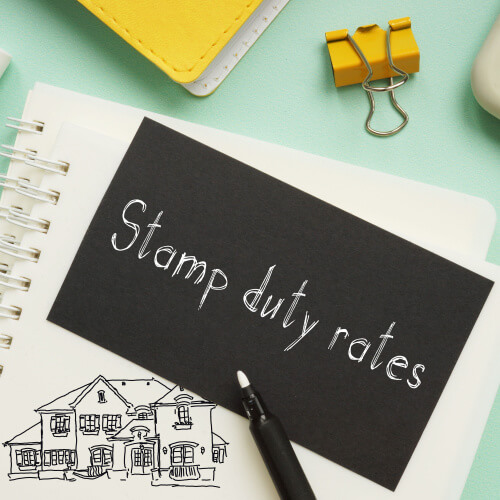 Written by James Hurwood
Written by James Hurwood
Reviewed by Stephen Zeller
Last updated 05/12/2023
Don't quite understand stamp duty? You might want to watch this explainer from Selling Houses Australia host, Andrew Winter.
![]()
Stamp duty will likely be one of your most significant upfront costs when buying a home, so it pays to be prepared and aware of how much transfer duty you’ll have to budget for. Our General Manager of Money, Stephen Zeller has some top stamp duty tips for property-buyers in the ACT:
Stamp duty charges will differ depending on where you’re buying real estate in Australia. When calculating your stamp duty, make sure you’re using the right set of state- or territory-based rates and concessions, otherwise you could be in for a nasty surprise when it comes time to pay your transfer duty.
It can be easy to overlook or forget stamp duty when tallying up your homebuying expenses, so be sure to account for it when weighing up your savings and the amount you’re looking to borrow.
Our expert Home Loan Specialist team are here to help with any stamp duty questions you might have, as well as any finance questions you’ve got on your mind. You can contact the team via phone or email and they’ll be happy to give you a hand!
As of September 2022, the ACT has two different sets of non-commercial stamp duty rates and thresholds: one for eligible owner-occupied transactions and one for non-eligible transactions.¹
| Stamp duty rates for eligible owner-occupied transactions | |
| Value of the property | Duty payable |
| Up to $260,000 | $0.60 for every $100 or part of $100 |
| $260,001 to $300,000 | $1,560, plus $2.20 for every $100 or part of $100 in excess of $260,000 |
| $300,001 to $500,000 | $2,440, plus $3.40 for every $100 or part of $100 in excess of $300,000 |
| $500,001 to $750,000 | $9,240, plus $4.32 for every $100 or part of $100 in excess of $500,000 |
| $750,001 to $1,000,000 | $20,040, plus $5.90 for every $100 or part of $100 in excess of $750,000 |
| $1,000,001 to $1,455,000 | $34,790, plus $6.40 for every $100 or part of $100 in excess of $1,000,000 |
| More than $1,455,000 | $4.54 for every $100 comprising the purchase price |
In order to qualify for the above, cheaper concessional rates of duty, at least one buyer must live in the residential property continuously for at least one year and take up residence within 12 months of the settlement date.
So, if you’ve purchased an investment property, you almost certainly won’t be eligible for those residential rates. Instead, you’ll likely pay the below rates.
| Stamp duty rates for non-eligible transactions | |
| Value of the property | Duty payable |
| Up to $200,000 | $1.20 for every $100 or part of $100 |
| $200,001 to $300,000 | $2,400, plus $2.20 for every $100 or part of $100 in excess of $200,000 |
| $300,001 to $500,000 | $4,600, plus $3.40 for every $100 or part of $100 in excess of $300,000 |
| $500,001 to $750,000 | $11,400, plus $4.32 for every $100 or part of $100 in excess of $500,000 |
| $750,001 to $1,000,000 | $22,200, plus $5.90 for every $100 or part of $100 in excess of $750,000 |
| $1,000,001 to $1,455,000 | $36,950, plus $6.40 for every $100 or part of $100 in excess of $1,000,000 |
| More than $1,455,000 | $4.54 for every $100 block of the purchase price |
In the ACT, stamp duty is payable 14 days after your property title is registered at Access Canberra.2 Note that the day your title is registered will not necessarily be the same day as your settlement date or date of purchase.
Stamp duty in the ACT is paid to the ACT Revenue Office after you’ve received your notice of assessment and can only be paid online. Payment options include BPAY and Electronic Funds Transfer (EFT). 2 However, your solicitor or conveyancer will generally handle this for you.

In the ACT, you will typically pay stamp duty on any purchase of vacant land, a home or a combination of the two – if you buy land with an established home on it, you’ll pay stamp duty on the combined value of the two.2
The ACT offers a number of different stamp duty concessions and exemptions:
Be sure to investigate the eligibility criteria for one of the above concessions or exemptions before beginning your home-buying process.
As of September 2022, the ACT does not have any stamp duty exemptions or concessions specifically for first home buyers, or a first home buyer grant of any sort. If a first home buyer isn’t eligible for the previously mentioned HBCS, they will generally have to pay the full amount of stamp duty on the full property value of their first property purchase.
As of September 2022, the ACT requires foreign purchasers to pay any and all stamp duty they’ve incurred. However, unlike some other parts of Australia, the ACT does not impose any additional stamp duty or a transfer fee surcharge on foreign buyers.
![]()
Stephen has more than 30 years of experience in the financial services industry and holds a Certificate IV in Finance and Mortgage Broking. He’s also a member of both the Australian and New Zealand Institute of Insurance and Finance (ANZIIF) and the Mortgage and Finance Association of Australia (MFAA).
Stephen leads our team of Home Loan Specialists, and reviews and contributes to Compare the Market’s banking-relating content to ensure it’s as helpful and empowering as possible for our readers.
1 ACT Revenue Office. Conveyance duty (2. Non-commercial transfer duty). 2022.
2 ACT Revenue Office. Conveyance duty (1. Overview). 2022.
3 ACT Revenue Office. Stamp duty concession for owner-occupiers. 2022.
4 ACT Revenue Office. Home buyer concession scheme (from 1 July 2019). 2022.